|
|
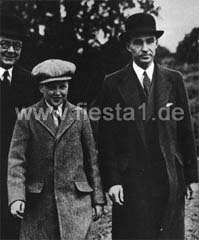
Henry Ford II with his father Edsel
at the laying of the foundation
stone at Dagenham At the end of the 1960s, Ford Motor Company began to show changes. On the one hand, the cooperation between the subsidiaries was improved. Most prominently this showed in the foundation of Ford Europe as a single organisation integrating Ford of Britain and Ford-Werke AG Germany. On the other hand Ford realised that they had to react to the growing demand for small cars, in the States and even more in Europe, a demand which even grew with the oil crisis of 1973. Until then, Ford had never built a small car, a so-called claß B car (like the Fiat 127, Renault 5, VW Polo). Although sketches and even models had previously been made, these studies were always cancelled at an early stage. These early attempts were based on smaller versions of cars that already existed. But making them smaller did only slightly reduce the costs for the metal, whereas production costs for other materials and personel basically stayed the same. Since the price of the smaller cars had to be noticably smaller, Ford believed at that time that this sector was not profitable.
In 1969 Ford of Europe once more tried to convince the American management of constructing a claß B car. The main arguments for a new try were that firstly the market for small cars had recognisably grown, and secondly the previous studies had started from wrong aßumptions. A claß B car should not be a smaller version of some other car, but should - inspite of the costs and risks - be planned as a completely new car.
On 30. September 1969 Ford of Europe was allowed to gather a task force and draw up a B car study. The budget was 100.000 $, the time eight months. The works on the B-Car, as it was called in the meantime, proceeded in Cologne-Merkenich (Germany), but the team was international. From the beginning, the potential costumers of the B-Car were thought to be international, too. The car should be sold in Europe, the United States, South America, and in the Asian-Pacific area. Even a more robust version for countries of the (then so-called) Third World was considered. In spite of the negative results of previous studies, two B-Cars based on the Escort were planned in addition to the entirely new one. Both front-wheel drive and rear-wheel drive were considered. Previous experiences with front-wheel drive had been painful for Ford: in 1962, the production of the Cardinal was cancelled only 60 days before it should have started, although the car was later built as Taunus 12M in Europe.1 However, every poßibilty was considered, nothing was apriori out of the question. Most of the European competitors were using front-wheel drive, and the potential costumers - as polls revealed later on - expected such a kind of technical improvement.
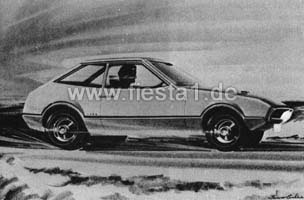
A first drawing: "Something a bit Italian..." In October 1970, the study - consisting of figures and tables and a 1:1 mockup, was presented. The results were thought to be promising, and it was decided that the project - now inofficially called Torino - should be presented to the management which at that time was headed by Henry Ford II and Lee Iacocca. In February 1971, this was done. To illustrate the early model (only technical questions had been considered so far, no members of the design department had taken part in the study), a few drawings of a designer based at Ford in Cologne were made, drawings which in no way referred to the study but where made only the night before the presentation. Convinced of what he saw, Lee Iacocca initiated more intensive studies of the B-Car in October 1971. Market analyses for Europe were performed, and in Dearborn a considerably larger team worked on the technical specifications for the B-Car, now often called Deutschlander due to its being initially planned in Merkenich. For the first time, designers were working on the project. Alternative studies were made by Ford USA and under Tom Tjaarda at Ghia in Turino. At this stage, Ford Europe did not work on the project since the development of the Escort II had top priority.
In autumn 1972 first results were presented. The teams had examined different models of competitors, most of all the Fiat 127, and developed a plan how to construct a car equally good or better than the Fiat 127. The first market analyses were carried out to estimate the prospects of the car, and to find out in as much it would compete with Ford's Escort. At the same time, the design teams at Dearborn/Detroit and at Ghia in Turino developed three pre-prototypes based on the Fiat 127: two so-called Mini-Mites, one with front-wheel drive and one with rear-wheel drive, and the Blue Car, which Tom Tjaarda delivered only 53 days after receiving the commißion:
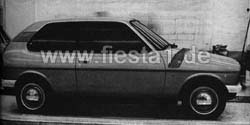 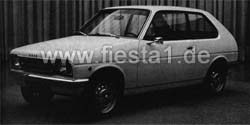 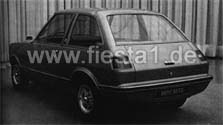
The Blue Car build in Turino (left), and the Mini-Mites from Dearborn.
Most importantly, an official code name was found for the project: On 2. October 1972, Hal Sperlich - at that time responsible for all aspects of the study - christianed the car Bobcat. The aßociation with the wild cat living in the north-american forests, and the fact that the letter B was taken in at prominent position, had made him choose the name. With it, and with thorough cost analyses, first market analyses and three pre-prototypes, the actual work could begin.
Unleß stated otherwise, all information and pictures are taken from Seidler (1977).2 Diese Seite auf deutsch -
Print version -
top -
front page |